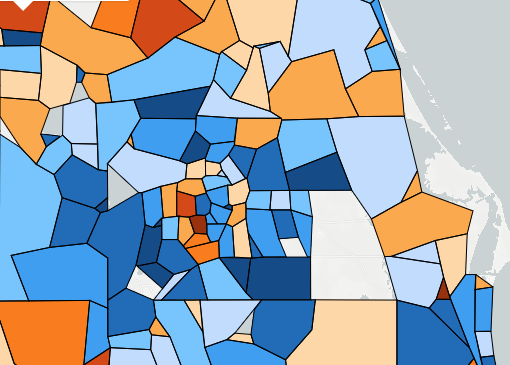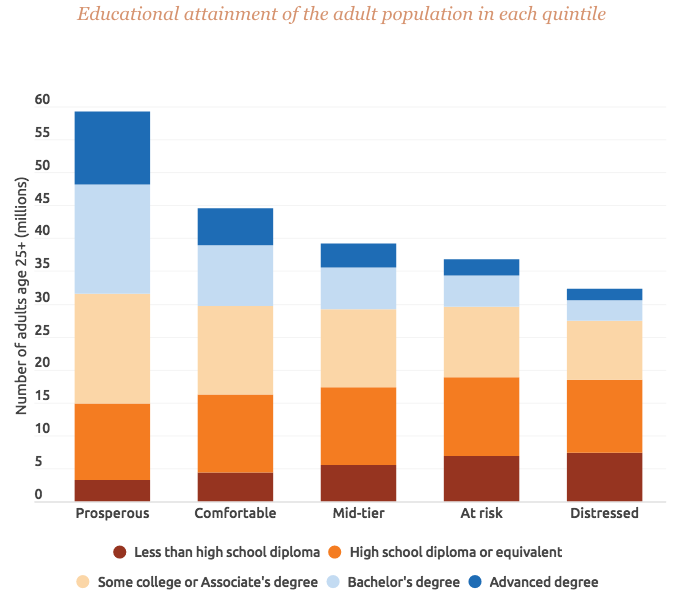America’s economy is increasingly driven by the concentration of talent in cities
The Economic Innovation Group (aka EIG, a DC-based think tank) has been compiling some interesting data on the relative economic performance of different parts of the US, in the form of their “Distressed Communities Index.” The recently enacted federal opportunity zones program is a brain-child of EIG, so identifying which places are distressed is a key aspect of their worldview.
They’ve released a new report “From Great Recession to Great Re-shuffling” offering a highly detailed view of change in the US economy over the past decade. Their report is based on set of indicators measuring relative economic performance of more than 25,000 zip codes. EIG has assembled data on the job characteristics and demographics of these zip codes from federal employment and Census records. The result is an interesting pointillist portrait of where the economy is doing well (and where it isn’t). They’ve got an on-line map showing the relative economic economic health. Best scoring zip codes are in blue, lowest scoring in orange and red.
This is a lot of data to make sense of, so the EIG report aggregates data for these 25,000 zip codes into five groups (with roughly 5,000 zip codes in each group), based on the relative performance of zip codes on a composite index of seven factors including income, poverty rates, education, business formation and job growth. They’ve labeled the five groups “prosperous, comfortable, mid-tier, at-risk, distressed.”
EIG’s own analysis highlights a number of interesting results from this aggregation: a large swath of the country still has fewer business establishments now than it did before the Great Recession, most job creation and business formation has been concentrated in more populous areas, and there’s been a net loss of population from the bottom two-fifths of zip codes since 2007.
The importance of education
Well-down the EIG list of findings was the one we found the most telling: The increasing concentration of talent in the most prosperous places. Here’s their chart showing the composition of the population of each of their five zip-code quintiles, based on educational attainment.
What’s striking is that each of these five groups has almost exactly the same number of people with less than a BA degree (about 30 million). The pronounced difference among places is in the number of adults with a BA (light blue) and the number with a graduate, professional or doctoral degree (dark blue). The most prosperous quintile of zip codes has 27.7 million adults with a bachelor’s degree or higher, nearly six times more than the 4.8 million that lived in distressed zip codes.
Even more striking, is the pattern of change over the past decade or so. The EIG report compares American Community Survey data from two time periods (2007-11 and 2012-16). They report that the number of advanced degree holders in the US increased by 3.7 million in that time. The increase in advanced degree holders was heavily concentrated in the most prosperous zip codes. Half of the increase in those with an advanced degree occurred in the top quintile of zip codes; only 5 percent of the increase was recorded in the lowest, “distressed” zip codes.
One one level, this data confirms the clustering of talent in the most prosperous places. Zip codes that have and attract well-educated workers are performing much better economically than those that don’t. As we’ve stressed at City Observatory, much of what’s going on here is the clustering of talent in the largest metropolitan areas, and within those areas, in close-in urban neighborhoods. The EIG data are consistent with this analysis. Their report observes a strong correlation between the educational attainment of a metropolitan area and the share of its population that lives in top-tier “prosperous” zip codes:
Metro area findings reinforce the education advantage. Tellingly, seven of the 10 major metro areas in which the largest share of the population resided in a prosperous zip code also ranked in the top 10 for bachelor’s and advanced degree attainment. . . . Conversely, six of the 10 major metro areas with the largest shares of their population living in distressed zip codes ranked in the bottom 10 on college degree attainment nationally.
The limits of zip codes
This is rich and detailed data, but zip codes are far from ideal as the geography to characterize economic performance. They don’t represent complete economies in any sense. Some zip codes (a downtown business district or industrial areas) are job centers, typically with far more employed workers than residents. Other zip codes are primarily residential, with few jobs (other than some local retail and service jobs. Few people live and work in the same zip code; almost no one, especially in a large metropolitan area has their economic prospects defined by the number or kind of jobs that happen to be in their zip code. For most Americans, one’s zip code reflects the kind of housing one can afford, rather than one’s place of employment. In important respects, zip code measures are really more revealing about sorting and economic segregation than they are about localized patterns of economic opportunity.
Let’s take a closer look at a couple of different metropolitan areas (Detroit and Orlando) to see the differences in geographic patterns of distress. First, here’s a map of the distress index for Southeast Michigan. It shows high levels of distress in the City of Detroit proper (dark red), surrounded by areas of blue (with a fair amount of dark blue); illustrating a well-known disparity in economic conditions between the city and its suburbs. (At this level of detail, the maps shift to a more cubist appearance).

And in contrast, here’s the same map for the Central Florida region centered on Orlando. Here the pattern is much more of a random patchwork, with few concentrations of extremely high performing or low performing zip codes in any particular area. In contrast to the stark city/suburb divide in Detroit, high performing and low performing zip codes are found all over Central Florida.

The challenge in interpreting the data from the EIG report is that national level aggregations of zip codes don’t tell us anything about the spatial pattern of economic performance within metropolitan areas. One’s diagnosis of the economic problems of a “distressed” zip code in Detroit (surrounded by dozens of other distressed zip codes) should probably be very different from that of Orlando (where distressed zip codes are few and tend to be adjacent to healthy zip codes.


